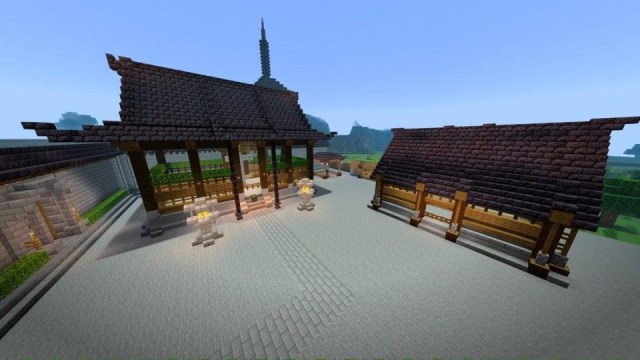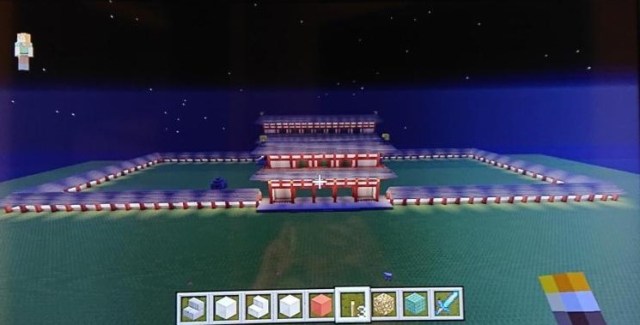
Junior high school students at one school are learning Japanese culture by recreating historical sites in the popular game.
Autumn is a popular season for school trips, when whole grades of students travel together to popular tourist sites throughout Japan to do some hands-on learning. But with coronavirus still a major threat, and travel limited as a result, many school trips have sadly been cancelled, or at least are being contained to the local area.
But while kids have to miss out on having a weekend in a hotel or at an onsen with their friends, they still get to have some fun, at least at Reitaku Junior and Senior High School in Chiba Prefecture. The students there will get to have a virtual school trip through the world-building video game Minecraft!
Second-year students at Reitaku Junior High School were originally scheduled to take a trip to Kansai this year to check out the historical sites at Ise, Kyoto, and Nara, but as expected their trip was cancelled. After some conferencing between students and teachers, the students came up with the idea to make their own school trip by recreating those sites in Minecraft, and the administration thought it was a great idea.
Minecraft has already been used in a school setting to create a digital graduation ceremony at the beginning of the pandemic, so it’s not entirely unheard of for it to apply to education. In the case of the graduation ceremony, however, the students organized it all on their own, instead of developing it during school hours or working together with teachers and staff to make it. The students at Reitaku, on the other hand, will be spending actual class time to recreate the most famous temples and shrines of the Kansai region under teacher supervision.
The “virtual school trip” in Minecraft was approved as a study of Japanese culture since it will be a great chance for the students to learn about the history, architecture, and culture of major sites like Ise Jingu Shrine, Todaiji Temple, and Kiyomizu-dera Temple, but the use of Minecraft to recreate them also has numerous other educational purposes as well. Teachers expect to it be a segway into learning about computer programming, and the project is expected to help develop students’ spatial awareness as well as math skills.
Students will be divided into teams to work together on different sites, which teachers consider appropriate, since on school trips the kids are often divided into groups to study and travel together. The hope is that students will also be improving their communication skills and their ability to work as a team. For some students, it will be a trial of leadership as well; as many more students are familiar with the game than teachers, those students have been selected to lead the projects.
The four main purposes to the assignment–allowing students to bond and make memories with their classmates, to study historical buildings, to teach each other and learn from each other, and to become comfortable with using Minecraft–are all, generally, the same objectives teachers would hope to achieve from a regular school trip (except for the use of Minecraft, of course), so it would seem that this is a suitable, if not equal, replacement for the missed experience.
To the students this might not be as fun as taking a trip across the country with their friends, but it sure beats writing essays, so hopefully they have a great time and learn plenty with this experience. Considering the amazing accomplishments that gamers have achieved within Minecraft in the past, we’re really looking forward to seeing their recreations of famous Japanese monuments!
Source, images: PR Times
● Want to hear about SoraNews24’s latest articles as soon as they’re published? Follow us on Facebook and Twitter!


 Petition to allow students to choose what they wear to school gathers almost 19,000 signatures
Petition to allow students to choose what they wear to school gathers almost 19,000 signatures Under 35 percent of middle school English teachers in Japan meet government proficiency benchmark
Under 35 percent of middle school English teachers in Japan meet government proficiency benchmark City of Kawasaki to rent out entire theme park for local elementary school students
City of Kawasaki to rent out entire theme park for local elementary school students Miss school field trips? Now adults can go on a “school trip” too with new plan at Nara hotel
Miss school field trips? Now adults can go on a “school trip” too with new plan at Nara hotel Five ways college life is different in Japan and the United States
Five ways college life is different in Japan and the United States Disney princesses get official manga makeovers for Manga Princess Cafe opening in Tokyo
Disney princesses get official manga makeovers for Manga Princess Cafe opening in Tokyo Our reporter takes her 71-year-old mother to a visual kei concert for the first time
Our reporter takes her 71-year-old mother to a visual kei concert for the first time Is the new Shinkansen Train Desk ticket worth it?
Is the new Shinkansen Train Desk ticket worth it? Hamburg and Hamburg Shibuya: A Japanese restaurant you need to put on your Tokyo itinerary
Hamburg and Hamburg Shibuya: A Japanese restaurant you need to put on your Tokyo itinerary Foreign English teachers in Japan pick their favorite Japanese-language phrases【Survey】
Foreign English teachers in Japan pick their favorite Japanese-language phrases【Survey】 You COULD eat a terrifying octopus egg in Japan, but SHOULD you? Let’s find out!【Taste test】
You COULD eat a terrifying octopus egg in Japan, but SHOULD you? Let’s find out!【Taste test】 Eight Japanese words we’d love to import into English
Eight Japanese words we’d love to import into English Hey, Japanese taxi driver! Take us to your favorite restaurant in Tsuruga City!
Hey, Japanese taxi driver! Take us to your favorite restaurant in Tsuruga City! Traditional silverwork pairs with the power of the moon in this stunning Silver Crystal pendant
Traditional silverwork pairs with the power of the moon in this stunning Silver Crystal pendant We try out “Chan Ramen”, an underground type of ramen popular in the ramen community
We try out “Chan Ramen”, an underground type of ramen popular in the ramen community New Studio Ghibli bedding sets are cool in all senses of the word
New Studio Ghibli bedding sets are cool in all senses of the word Our Japanese reporter visits Costco in the U.S., finds super American and very Japanese things
Our Japanese reporter visits Costco in the U.S., finds super American and very Japanese things New Pokémon cakes let you eat your way through Pikachu and all the Eevee evolutions
New Pokémon cakes let you eat your way through Pikachu and all the Eevee evolutions There’s a park inside Japan where you can also see Japan inside the park
There’s a park inside Japan where you can also see Japan inside the park Japanese convenience store packs a whole bento into an onigiri rice ball
Japanese convenience store packs a whole bento into an onigiri rice ball Hanton rice — a delicious regional food even most Japanese people don’t know about, but more should
Hanton rice — a delicious regional food even most Japanese people don’t know about, but more should Final Fantasy, Kingdom Hearts, and Dragon Quest pet product line announced by Square Enix
Final Fantasy, Kingdom Hearts, and Dragon Quest pet product line announced by Square Enix Studio Ghibli releases Kiki’s Delivery Service chocolate cake pouches in Japan
Studio Ghibli releases Kiki’s Delivery Service chocolate cake pouches in Japan Japan’s bone-breaking and record-breaking roller coaster is permanently shutting down
Japan’s bone-breaking and record-breaking roller coaster is permanently shutting down New definition of “Japanese whiskey” goes into effect to prevent fakes from fooling overseas buyers
New definition of “Japanese whiskey” goes into effect to prevent fakes from fooling overseas buyers Foreign passenger shoves conductor on one of the last full runs for Japan’s Thunderbird train
Foreign passenger shoves conductor on one of the last full runs for Japan’s Thunderbird train Kyoto bans tourists from geisha alleys in Gion, with fines for those who don’t follow rules
Kyoto bans tourists from geisha alleys in Gion, with fines for those who don’t follow rules Studio Ghibli unveils Mother’s Day gift set that captures the love in My Neighbour Totoro
Studio Ghibli unveils Mother’s Day gift set that captures the love in My Neighbour Totoro Domino’s Japan now sells…pizza ears?
Domino’s Japan now sells…pizza ears? Toyota built a life-sized Miraidon Pokémon and are letting people test drive it this weekend
Toyota built a life-sized Miraidon Pokémon and are letting people test drive it this weekend New Japanese KitKat flavour stars Sanrio characters, including Hello Kitty
New Japanese KitKat flavour stars Sanrio characters, including Hello Kitty Sales of Japan’s most convenient train ticket/shopping payment cards suspended indefinitely
Sales of Japan’s most convenient train ticket/shopping payment cards suspended indefinitely Sold-out Studio Ghibli desktop humidifiers are back so Totoro can help you through the dry season
Sold-out Studio Ghibli desktop humidifiers are back so Totoro can help you through the dry season Japanese government to make first change to romanization spelling rules since the 1950s
Japanese government to make first change to romanization spelling rules since the 1950s Ghibli founders Toshio Suzuki and Hayao Miyazaki contribute to Japanese whisky Totoro label design
Ghibli founders Toshio Suzuki and Hayao Miyazaki contribute to Japanese whisky Totoro label design Doraemon found buried at sea as scene from 1993 anime becomes real life【Photos】
Doraemon found buried at sea as scene from 1993 anime becomes real life【Photos】 Tokyo’s most famous Starbucks is closed
Tokyo’s most famous Starbucks is closed One Piece characters’ nationalities revealed, but fans have mixed opinions
One Piece characters’ nationalities revealed, but fans have mixed opinions We asked a Uniqlo employee what four things we should buy and their suggestions didn’t disappoint
We asked a Uniqlo employee what four things we should buy and their suggestions didn’t disappoint Princesses, fruits, and blacksmiths: Study reveals the 30 most unusual family names in Japan
Princesses, fruits, and blacksmiths: Study reveals the 30 most unusual family names in Japan Studio Ghibli’s new desktop Howl’s Moving Castle will take your stationery on an adventure
Studio Ghibli’s new desktop Howl’s Moving Castle will take your stationery on an adventure Nihon-no: Is an entirely English-speaking village coming to Tokyo?
Nihon-no: Is an entirely English-speaking village coming to Tokyo? Japanese middle schoolers build an awesome real/VR roller coaster for their class project【Video】
Japanese middle schoolers build an awesome real/VR roller coaster for their class project【Video】 Is Japan overworking its teachers? One exhausted educator says, “YES!”
Is Japan overworking its teachers? One exhausted educator says, “YES!” 1 in 20 Japanese junior high school students regularly missing school, government study finds
1 in 20 Japanese junior high school students regularly missing school, government study finds Japanese teacher beats up student for making fun of his body by calling him anime character name
Japanese teacher beats up student for making fun of his body by calling him anime character name Japanese teacher has student make written apology for farting in class, displays it in classroom
Japanese teacher has student make written apology for farting in class, displays it in classroom Japanese Youth Conference petitions government to end compulsory after-school club activities
Japanese Youth Conference petitions government to end compulsory after-school club activities Japan’s most famous anime/manga artist trade school now has a fully online program
Japan’s most famous anime/manga artist trade school now has a fully online program What’s wrong with English education in Japan? Pull up a chair…
What’s wrong with English education in Japan? Pull up a chair… Foreign English teacher in Japan calls student’s ability garbage, says it was an “American joke”
Foreign English teacher in Japan calls student’s ability garbage, says it was an “American joke” Don’t like trigonometry? Then you’re just like Hitler, says Japanese high school English teacher
Don’t like trigonometry? Then you’re just like Hitler, says Japanese high school English teacher High school teacher’s summer vacation homework about appreciating life brings tears to our eyes
High school teacher’s summer vacation homework about appreciating life brings tears to our eyes American English teacher fired from Japanese high school after exposing genitals
American English teacher fired from Japanese high school after exposing genitals Japanese high school teachers forcibly cut off hair that was “too long” from 44 students
Japanese high school teachers forcibly cut off hair that was “too long” from 44 students Former schoolgirl sues Tokyo high school that made her drop out for breaking no-dating rule
Former schoolgirl sues Tokyo high school that made her drop out for breaking no-dating rule Japanese university globalizes with fall start date, governor wants English as official language
Japanese university globalizes with fall start date, governor wants English as official language
Leave a Reply